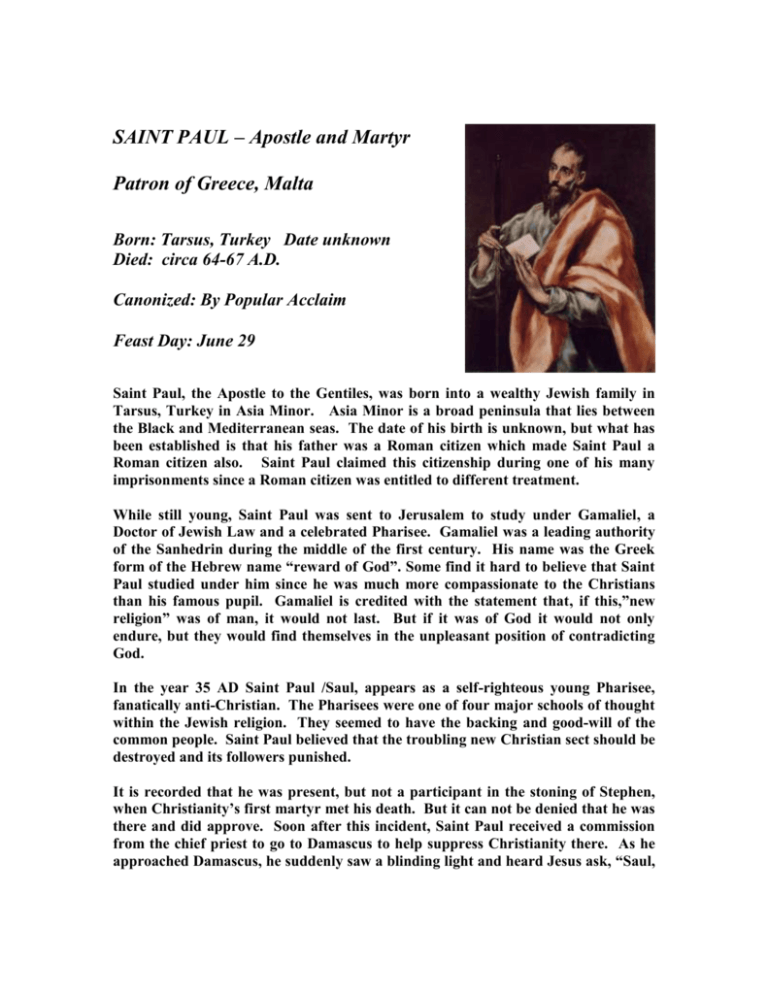SAINT PAUL THE APOSTLE - Dead Theologians Society
advertisement

SAINT PAUL – Apostle and Martyr Patron of Greece, Malta Born: Tarsus, Turkey Date unknown Died: circa 64-67 A.D. Canonized: By Popular Acclaim Feast Day: June 29 Saint Paul, the Apostle to the Gentiles, was born into a wealthy Jewish family in Tarsus, Turkey in Asia Minor. Asia Minor is a broad peninsula that lies between the Black and Mediterranean seas. The date of his birth is unknown, but what has been established is that his father was a Roman citizen which made Saint Paul a Roman citizen also. Saint Paul claimed this citizenship during one of his many imprisonments since a Roman citizen was entitled to different treatment. While still young, Saint Paul was sent to Jerusalem to study under Gamaliel, a Doctor of Jewish Law and a celebrated Pharisee. Gamaliel was a leading authority of the Sanhedrin during the middle of the first century. His name was the Greek form of the Hebrew name “reward of God”. Some find it hard to believe that Saint Paul studied under him since he was much more compassionate to the Christians than his famous pupil. Gamaliel is credited with the statement that, if this,”new religion” was of man, it would not last. But if it was of God it would not only endure, but they would find themselves in the unpleasant position of contradicting God. In the year 35 AD Saint Paul /Saul, appears as a self-righteous young Pharisee, fanatically anti-Christian. The Pharisees were one of four major schools of thought within the Jewish religion. They seemed to have the backing and good-will of the common people. Saint Paul believed that the troubling new Christian sect should be destroyed and its followers punished. It is recorded that he was present, but not a participant in the stoning of Stephen, when Christianity’s first martyr met his death. But it can not be denied that he was there and did approve. Soon after this incident, Saint Paul received a commission from the chief priest to go to Damascus to help suppress Christianity there. As he approached Damascus, he suddenly saw a blinding light and heard Jesus ask, “Saul, why do you persecute Me?” He was temporarily blinded and had to be assisted into Damascus like a child or one dependent on others, not as a warrior. There, a disciple of Christ, Ananias, was informed that he was to receive this Saul into his home. At first, he was afraid because he knew of this young man’s reputation towards the Christians. But listening to the Holy Spirit and fulfilling God’s will he received Saul and baptized him. Paul (now the former Saul), also obeying the Holy Spirit, received back his sight. Saint Paul eagerly accepted the commission to preach the Gospel of Christ, but like others called to a great work he felt unworthy. He withdrew for a significant period of time, often living in the Arabian Desert, to meditate and pray before beginning his apostolate. Some say this period of preparation was as short as three years to a length of thirteen years. He set out on his first missionary journey around 47-49 AD accompanied by St. Barnabas and for a time St. Mark. Saint Paul began his preaching in Damascus. Here the anger of the orthodox Jews against this traitor was so great that he had to make his escape by having himself lowered over the city wall in a basket. From there he went to Jerusalem where he was received by the Christians with suspicion because of his past history. Saint Paul returned to Tarsus with St. Barnabas before traveling to Antioch in Syria where they were so successful in preaching about Jesus Christ that a church, later to become famous, was founded. In Antioch, the followers of Jesus were the first to be called Christians. Saint Paul spent most of his time traveling especially to towns with Jewish settlements. It was his practice in such places, first to visit the synagogues and preach to the Jews. If rejected by them, he would then preach to the Gentiles. At Antioch, Saint Paul delivered a memorable sermon to the Jews and ended by saying, “It was necessary that the word of God should be spoken to you first. But since you reject it and judge yourselves unworthy of eternal life, behold we now turn to the Gentiles, for so the Lord commanded us”. After this, the Jews drove Saint Paul and Saint Barnabas out of their midst. The second missionary journey lasted from 49-52 AD. Saint Paul had a disagreement with Saint Barnabas and Silas was chosen to become Saint Paul’s new assistant. They began preaching in Galatia in Turkey and Troas, an important port city along the Aegean Sea. It was there, it is said, Saint Paul had a vision of a man who told him to go to Macedonia. Macedonia is a country located near Greece on the European mainland. The physician Luke was now a member of the party and in the Book of Acts; he gives us a record of their travels. Saint Paul taught in Thessalonica, Athens and Corinth. In Athens, Saint Paul gave his famous discourse on the “unknown god”. When he entered Corinth, he found himself in the very heart of the Greek-Roman world and his letters of this period show that he was aware of the great odds against him. He knew of the ceaseless struggle that had to be waged in overcoming pagan skepticism and indifference. Nevertheless he stayed in Corinth for eighteen months and met with considerable success. Two valuable workers, the husband and wife team of Aquila and Priscilla, joined him and returned with him to Asia. It was in his first winter at Corinth that Paul wrote the earliest extant missionary letters. They showed his supreme concern for conduct and his belief in the indwelling of the Holy Spirit which gives men power for good. It is believed that in Corinth he wrote the First and Second letters to the Thessalonians and possibly his letter to the Galatians. The third missionary journey of Saint Paul, probably around 53-57 AD, took him to Galatia, then Phrygia and over to Ephesus. His two and a half years in Ephesus was one of the most fruitful periods of his life. It was during this time he wrote his two letters to the Corinthians. He had gone to Corinth to help the early Christians there. He also probably wrote the Epistle to the Romans while in Corinth. In Ephesus, where the cult of the Greek goddess Diana was very popular Saint Paul raised a disturbance against the cult and the trade in silver images of the goddess by proclaiming Jesus Christ as the one true God. He finally left Ephesus to return to Jerusalem where he was arrested for causing a riot when visiting the temple. He was accused of letting a gentile enter the temple. This was reason enough for the immediate death of the gentile. Saint Paul was roughly handled and bound with chains. When he was brought before the tribunal he defended himself in a way that impressed his captors. He was taken to Caesarea, for it was rumored that some Jews at Jerusalem, who had falsely accused him of having admitted Gentiles to the Temple, were plotting to kill him. He was kept in a prison in Caesarea awaiting trial for close to two years. The Roman governors apparently wished to avoid trouble with both Jews and Christians and so postpone judgment from month to month. At last, Saint Paul appealed to the Emperor demanding the legal right of a Roman Citizen to have his case heard by Nero himself. He was placed in the custody of a centurion who took him to Rome. On the way they were ship wrecked in Malta. AD 60 finds Saint Paul in Rome, but apparently able to conduct his ministry among the Roman Christians and Jews who visited him in prison. Before his death Saint Paul appointed Titus bishop of Crete and Timothy bishop of Ephesus. After two years in chains Saint Paul suffered martyrdom most likely about the same time as Saint Peter. Of his final fate, tradition says that he was beheaded south of the city near the Ostian Way, probably during the persecution of Nero. Historians believe that Saint Paul died between the years 64-67 AD. In the year 51AD, Nero was proclaimed an adult at the age of 14. And he became Emperor of Rome in 54AD at the age of 16 after the death of Claudius. Nero might have been 26 or 27 years old at the time of Saint Paul’s death. Much has been written of Nero, some of it positive and some of it negative. Nero’s rule has often been associated with tyranny and extravagance. He is known for a number of executions, including those of his mother and adoptive brother and as an early persecutor of Christians. Saint Paul was a problem he did not need. What is important here is not Nero and what he did, but Saint Paul and what he did. Saint Paul’s figure dominates the early apostolic age of the new Christian church and his epistles have left a tremendous impression on Christianity. The first Christian theological writing is found in them, where it is characterized by spiritual fervor rather than by analysis. Saint Paul became a fountainhead of Christian Doctrine. Roman Catholic theology leans upon him at all times. There can be no doubt that Saint Paul’s interpretation of the life, death and resurrection of Jesus, his doctrine of the church as the mystical body of Christ, his teaching on law and grace, and his view of justification have been decisive in the formation of the Christian faith. St. Paul celebrates his feast day with Saint Peter as one of the principal days of the church calendar. The conversion of Saint Paul is commemorated on January 25. Saint Paul was an intense human being, first as an orthodox Jew and latter as an Apostle of Christ. He said “yes” to the call of Christ without knowing what was to come because of this yes. Now it is known that his “yes” was a continual road of suffering. He was misunderstood on all sides, was feared because of his past history, and was hated because of what he was calling others to do. The information that is presented here should lead us to study in depth the life of this saint, who at a young age, was called to such heroic action. It can not be asked of us if we would be as brave as Saint Paul for Saint Paul himself would not have known the answer to that question. It can only be asked of us if we, like Saint Paul, would be ready to say “yes” to our call, trusting completely that we could fulfill the yes, because the person asking the question is Jesus Christ Crucified. Saint Paul kept saying “yes” to Christ in trust. That is our calling also. Saint Paul lived during the very early beginnings of the Christian Church. There is a good deal of information available and a good deal of that same information is still under discussion and study today. The exact dates and times are not so important, as the message. “ with eyes wide open to the mercies of God, I beg you my brothers, as an act of intelligent worship to give Him your bodies, as a living sacrifice, consecrated to Him and acceptable by Him. Don’t let the world around you squeeze you into its mold, but let God re-mould your minds from within so that you may prove in practice that the plan of God for you is good, meets all His demands and moves towards the goals of true maturity”. Rom 12:1-2 RESOURCES: http://www.infoplease.com/ce6/people/A0837893.html http://en.wikipedia.org/wiki/Nero http://www.crystalinks.com/asiaminor.html http://www.ewtn.com/library/MARY/PAUL.HTM http://en.wikipedia.org/wiki/Gamaliel http://www.catholic.org/printer_friendly.php?id=91&section=Saints+%26+Angels http://www.sacred-destinations.com/turkey/tarsus.htm http://en.wikipedia.org/wiki/Pharisees http://en.wikipedia.org/wiki/Saint_Paul http://osv.com/Year ofStPaul/tabid/6133/Default.aspx – 60k –








